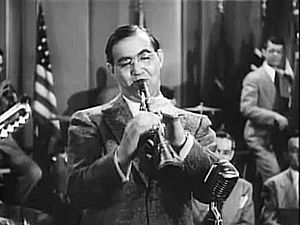Swing music facts for kids
Quick facts for kids Swing |
|
|---|---|

Benny Goodman, one of the first swing bandleaders to achieve widespread fame.
|
|
| Stylistic origins |
|
| Cultural origins | 1930s, United States |
| Derivative forms | |
| Subgenres | |
| Swing revival | |
| Fusion genres | |
| Electro swing | |
| Regional scenes | |
| Western swing | |
Swing music is a fun and energetic type of music. It became very popular in the United States during the 1930s and 1940s. The name 'swing' comes from how the music feels. It has a special rhythm where some beats are emphasized more than others. This gives it a lively, bouncing sound.
Swing bands often had soloists who would make up their own melodies on the spot. This was done over the main music. The danceable style of big bands and their leaders, like Benny Goodman, was the most popular music in America from 1935 to 1946. This time is known as the swing era. When musicians "swing", it means they are playing with a strong, exciting rhythm. Famous swing musicians include Louis Armstrong, Duke Ellington, Count Basie, Benny Goodman, Glenn Miller, and Cab Calloway.
Contents
How Swing Music Started
Swing music began in the 1920s. At that time, larger dance music groups started using new ways to arrange their songs. They added special rhythms first used by musicians like Louis Armstrong and Earl Hines.
A typical swing song would have a strong rhythm section. This part of the band kept the main beat steady. Other instruments, like wind and brass, played more freely over this beat. Most swing songs had a main melody played first. Then, musicians would take turns playing their own improvised solos. Their bandmates would play supporting music behind them.
Why Swing Changed
Swing music started to become less popular during World War II. Many things caused this change. However, swing music influenced many later styles. These include traditional pop music, jump blues, and bebop jazz.
Swing music became popular again in the late 1950s and 1960s. This was thanks to the renewed popularity of orchestras led by Count Basie and Duke Ellington. Pop singers like Frank Sinatra and Nat King Cole also helped bring swing back.
Swing Blends with Other Music
Swing music also mixed with other types of music. This created exciting new styles.
Western Swing
In country music, artists like Jimmie Rodgers and Bob Wills added swing elements. They also mixed in blues music. This blend created a new genre called western swing.
Gypsy Swing
Gypsy swing grew out of the jazz violin style of Joe Venuti and Eddie Lang. It has a unique sound that mixes swing with Gypsy music traditions.
Swing Revivals
Swing music has had several comebacks over the years. These revivals happened from the late 1960s all the way into the 2000s.
- In the late 1980s and early 1990s, a new style called new jack swing appeared. This was a more modern, city-style swing beat. Teddy Riley was a key artist in this movement.
- In the late 1990s and 2000s, there was another big swing revival. Bands like Squirrel Nut Zippers, Brian Setzer, Big Bad Voodoo Daddy, and Lavay Smith led this movement.
- In Canada, some early 2000s music by The JW-Jones Blues Band also included elements of the swing revival.
See also
In Spanish: Swing (jazz) para niños

